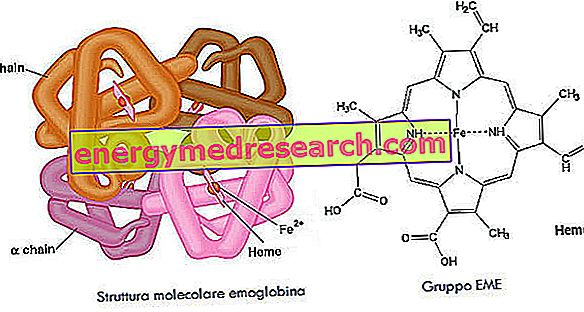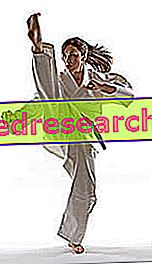Generality
Essential tremor is a pathology belonging to the group of movement disorders.

More precisely, essential tremor is a very common movement disorder that tends to manifest itself in adult individuals over the age of 40, but in rare cases it can also occur in younger or even adolescent or child age individuals.
The causes of this disease are not yet known, although the hypotheses on the subject are different. Unfortunately, given the unknown aetiology, there is no cure aimed at eliminating the disease and the treatments currently available are mostly symptomatic.
Curiosity
In the past, essential tremor was defined as "benign essential tremor". However, since in particularly serious cases the disorder in question can be decidedly debilitating for the patient, the adjective "benign" has been removed from the name.
What is that
What is Essential Tremor?
Essential tremor is a particular type of movement disorder characterized - as can easily be guessed by the name of the disorder - by a tremor, postural and kinetic, mainly located in the upper limbs and head.
It is a chronic type of disease whose manifestations can be worsened by states of agitation and nervousness, emotion and the presence of any states of anxiety.
Generally speaking, essential tremor is not considered as a movement disorder capable of endangering the health of the patient, provided the latter does not consider it a discomfort so great as to negatively affect his psychological sphere, favoring the appearance of disorders such as social isolation, anxiety or depression. In the presence of similar pathological conditions, if the patient is not adequately supported from the psychological point of view, there is the risk that this assumes dangerous behaviors for himself.
Incidence
As mentioned, essential tremor is one of the most common movement disorders. It tends to manifest itself more in adult individuals over the age of forty. In any case, the incidence tends to increase gradually with increasing patient age. Not by chance, at one time, essential tremor was defined as " senile tremor ", as it was prevalent in patients over 60 years of age.
However, in some cases - although extremely rare - the disease can also occur in young adults, adolescents and infants.
Essential tremor affects both sexes without distinction; however, it appears to be slightly prevalent among Caucasian individuals compared to black individuals.
Causes
What are the Causes and Risk Factors of Essential Tremor?
The underlying causes of the onset of essential tremor have not yet been precisely identified. There are many hypotheses regarding this and all seem to agree on the presence of a genetic component . Some also suggest that in the development of the disease there may also be the involvement of environmental factors (for example, exposure to certain pollutants, such as lead) and even dietary factors. However, these last hypotheses have not been confirmed.
Please note
Some forms of essential tremor are defined as " essential family tremor " because they manifest themselves in different members of the same family. In these situations, genetic involvement is indisputable. More precisely, it has been concluded that - in similar circumstances - the essential tremor takes on the characteristics of an autosomal dominant disease.
However, despite the lack of clarity about the real causes of the disease, from the investigations conducted by magnetic resonance (NMR) and positron emission tomography (PET), it emerged that the involvement of the cerebellum could occur in the onset of essential tremor and its efferent features.
Symptoms
Manifestations and Symptoms of Essential Tremor
The typical symptom of essential tremor is represented, of course, by the tremor that usually involves the upper limbs, the head (shaking of the head when without support) and the voice (patients tend to speak with a tremulous voice), but which can potentially involve also other body areas.
The tremor occurs both when the patient takes and remains in a certain position ( postural tremor ), and when the patient performs voluntary movements ( kinetic tremor ).
Normally, there are no weaknesses and alterations in muscle tone, symptoms that instead manifest themselves in the presence of other movement disorders. Nevertheless, the localized tremor in the upper limbs, the voice and the head can make it difficult to perform even the simplest actions, such as eating, drinking, grabbing objects and communicating.
In some cases, the essential tremor can evolve in an almost dramatic way, becoming a real disability for the patient who cannot even perform the most basic tasks.
Furthermore, tremors - which can occur even when the patient is in public places and which can hinder the performance of normal daily activities - can negatively affect the psychology of the individual. In fact, it is not uncommon for essential tremor - seen in an extremely negative way by the patient - to cause great embarrassment and disability which, in turn, can potentially lead to social isolation, anxiety and even depression.
Factors that worsen the Symptoms of Essential Tremor
The manifestations and symptoms of essential tremor can be aggravated by several factors, such as:
- Nervousness and agitation;
- Anxious states;
- Emotional factors.
In addition to what has been said so far, the symptoms of essential tremor can worsen even when the patient has to perform tasks or perform movements in awkward positions and / or which require some effort.
Associated pathologies
Can Essential Tremor be associated with other Movement Disorders?
Based on the data available so far, it has emerged that essential tremor can in fact be associated with other movement disorders. In this regard, it has been estimated that about 20% of patients with essential tremor can develop parkinsonism, that is particular movement disorders with symptoms similar to those of Parkinson's disease, but with different origins and course. Among the symptoms triggered by these disorders, we find:
- Muscle stiffness;
- Hypertonia;
- Dysarthria;
- bradykinesia;
- Walking disorders;
- Dyskinesia;
- Cramps and spasms;
- Changes in equilibrium.
Diagnosis
How is essential tremor diagnosed?
The diagnosis of essential tremor is usually made based on the patient's symptoms and based on a thorough and complete neurological examination. The doctor may also use the results provided by diagnostic tests such as positron emission tomography or MRI.
Unfortunately, there are no blood tests or specific tests to diagnose this disease. Therefore, on the basis of the data collected from the anamnesis and diagnostic tests mentioned above, the doctor must be able to make a correct diagnosis, excluding the presence of other movement disorders or other underlying causes of tremors.
Care
Care and Treatment of Essential Tremor
Unfortunately, there is no specific and definitive cure for the treatment of essential tremor. The therapeutic strategies currently available are therefore purely symptomatic and are not able to definitively eliminate the disease.
If essential tremor occurs in mild form, it is generally not necessary to resort to any therapy.
When the tremor is moderate or severe, however, it is possible to subject the patient to a pharmacological therapy which, of course, must be prescribed by the neurologist. The active ingredients mostly used in cases of essential tremor are:
- Propranolol (Inderal®) is a beta-blocker drug also used in the treatment of hypertension. This active ingredient appears to be effective in controlling the tremors induced by the disorder, but side effects (fatigue, depression, etc.) may limit the dosage administered.
- Primidone (Mysoline®) is an anti-epileptic that can be useful in controlling symptoms induced by essential tremor. However, even in this case, side effects such as sleepiness and mental confusion can limit its use.
Finally, some patients respond well to treatment with gabapentin (Neurontin®) or acetazolamide (Diamox®).
Please note
The efficacy of drug therapy of essential tremor may vary from patient to patient. For example, if for one patient propranolol can be effective, for another patient it may be poorly useful or completely ineffective.
Furthermore, in many cases, essential tremor tends to be drug-resistant when it occurs in elderly patients and young adults .
Surgical Treatment of Essential Tremor
In particularly severe cases of essential tremor, especially if drug-resistant, the doctor may find it necessary to resort to surgery. More in detail, it is possible to intervene through:
- Talamotomy, a particular type of neurosurgical intervention used in the treatment of extrapyramidal syndromes and in pain therapy.
- The implantation of endocerebral high-frequency stimulating devices at the thalamus level, in order to perform the so-called deep brain stimulation (DBS).
These particular and delicate surgical interventions are generally carried out in specialized centers.
Did you know that ...
Some patients with essential tremor tend to abuse alcohol, as ethyl alcohol is able to suppress - at least partially - the typical tremor of the disease. Clearly, this practice is absolutely contraindicated in any situation; alcohol abuse, in fact, in addition to causing extensive damage to the body, gives rise to a real pathological dependence. If you suffer from essential tremor, you should contact a specialist who, once the disease is diagnosed with certainty, will indicate to the patient the best - and above all safe - therapeutic strategies to reduce the symptoms.



